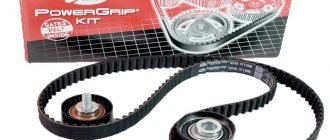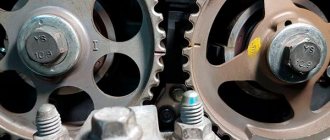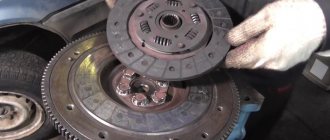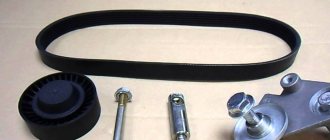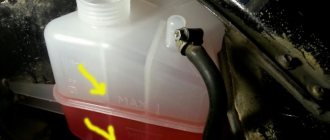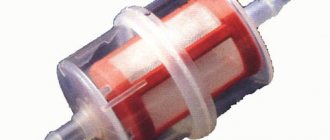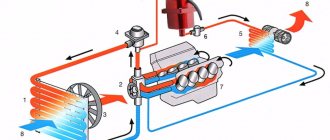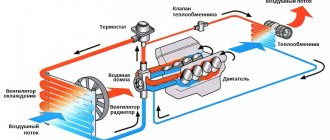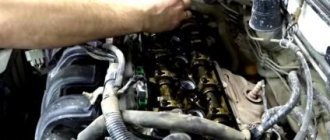Coca Cola is not only a tasty carbonated drink for him, but also an excellent calcium deposit dissolver. Therefore, experienced car owners recommend pouring Coca-Cola into the car radiator, which, in their opinion, dissolves rust and accumulated deposits, thereby improving the cooling of the car engine. Let's talk in more detail about whether it is really possible to use this Coca-Cola to dissolve existing contaminants and improve the condition of the car's cooling system.
This is due to the presence of phosphoric acid in cola.
Cleaning the car cooling system with Coca Cola
So, let's name the main advantages of such flushing of the engine cooling system:
- Coca Cola, due to its chemical composition, does not react with metal compounds;
- The concentration of orthophosphoric acid in the drink is minimal, so it does not cause any harm to humans;
- Coca Cola is much cheaper than its special analogues, although it is not inferior to them in terms of cleaning efficiency;
Flushing a car radiator with cola
How to use Coca-Cola to clean the cooling system?
Cola should not be constantly poured into the radiator. This should only be done before or during flushing of the cooling system. It is necessary to flush the radiator, especially if the coolant was water.
When the car engine is cooled with water, the process of scale formation begins in the cooling system. It presses on almost all elements of the system, among them: radiator, sensors, engine block, couplers, thermostat and many others. Coca-Cola will do an excellent job of dissolving such deposits and will not harm the cooling system.
Before cleaning, drain about a liter of antifreeze. Next, fill in Coca-Cola; this is done simply through the radiator cap. The product can also be poured through the expansion tank. In this case, the engine must be turned on while flushing the cooling system.
Why clean the cooling system?
The majority of people consider it a closed loop, where, by definition, nothing extra can get into it. Therefore, there is no need to clean it. However, this is a deep misconception. The cooling system even has several paths through which potential congestion enters.
In the summer, some car enthusiasts pour water into the radiator. Its quality has long been known to everyone. People buy peeled ones for cooking and drinking. But they pour it into regular CO, from the tap. There are rare cases where distilled water is purchased for a radiator. The result: the tubes and channels of the cooling system are gradually overgrown with the most common scale.
Winter is antifreeze in CO. There is no scale from antifreeze. But they decompose over time, and the compounds formed in this process provoke rusting.
The third path is determined by the location of the radiator. Dust, insects and other objects accompanying movement successfully clog the radiator, especially if it has a large-mesh grille. And for all its isolation, CO is by no means hermetically sealed.
So the system needs to be washed. It’s just that this is done quite rarely – once every 2-3 years, depending on the make, model and operating conditions – so some motorists completely forget about it. What, by the way, you shouldn’t do: if the CO works abnormally, you can expect extensive and unpleasant consequences:
- as a consequence, its diverse failure;
- pump breakdown;
- weak operation of the stove or complete lack of heating in winter.
If the warning light on the dashboard comes on, don’t be lazy and start flushing with CO.
Engine cooling system flushing products
Distilled water
Distilled water does not leave scale in the engine cooling system.
- We drain coolant from the radiator (plastic screw from the bottom or from the lower pipe) and from the cylinder block (metal bolt in the center, its location has a lot of variations) into a large, clean container (in order to assess the degree of contamination).
- We tighten the drain plugs.
- Pour distilled water into the expansion tank (and into the radiator, if there is a separate cap).
- We start the engine for 15-20 minutes.
- Drain the dirty water.
- If the water is very dirty, we make another circle for 15-20 minutes, drain again and look. Repeat the procedure until the water is clear.
- Fill in new antifreeze or antifreeze.
Is it necessary to flush the cooling system?
Car owners often mistakenly believe that high-quality antifreeze does not contain any impurities; therefore, there is no need to maintain the system in any way by flushing the radiator and numerous pipes and cooling channels in the engine itself. Over time, even high-quality antifreeze begins to decompose, corrosion processes are activated, and deposits appear on the internal elements of the radiator, which after approximately 5-8 years of vehicle operation can degrade the heat transfer efficiency of the antifreeze heated in the engine by a third.
That is why even the automakers themselves, in the documentation for their cars, indicate the need to carry out such work and mandatory cleaning of radiators and cooling systems from the resulting scale. Such work should be carried out at least once every 100,000 kilometers, and it is recommended to use appropriate chemistry. It is both safe for metal and rubberized pipes and at the same time converts all rust, which is subsequently removed with old antifreeze.
flushing the stove with Coca Cola
There is a widespread version about good results that are obtained by flushing the stove with Coca-Cola, the same applies to the cooling system, so we would like to discuss this myth in more detail.
Let's start with the fact that we ourselves have not used this method of cleaning the stove and therefore our opinion is ambiguous. On the one hand, it seems to be true. This drink contains phosphoric acid and many other active substances that destroy blockages. There are a lot of videos where various experimenters show the hidden possibilities of this drink.
However, we must remember that Coca Cola also contains a lot of sugar. And when heating, there is a risk of getting the opposite result instead of cleaning the stove radiator - an even more severe blockage. Sugar, turning into caramel, can kill the system completely.
Alternatively, you can remove the heater core and soak it in a drink. Or even boil it in Coca-Cola. And then wash thoroughly with water. But it’s easier not to experiment and clean the heater radiator without removing it from the car, for example, in our Center. Of course, if you have certain skills, you can wash the stove without removing it yourself, it’s up to you, but we recommend turning to professionals!
If we talk about our center, we use two reagents in our work.
The first reagent (alkaline composition) removes scale and sediment from the radiator, the second reagent completely neutralizes the first, which prevents its harmful effects in the future.
Now you understand that flushing the stove radiator with Coca Cola is not an entirely correct and complete cleaning process. This method can be classified as folk, but it does not fit in with the professional approach. It just so happens that people are trying to find alternative and inexpensive ways to solve this issue, but still, if you decide to clean the stove radiator, contact us and you will be delighted with the result.
Let me give you a few recommendations that will allow you to avoid flushing the stove with Coca-Cola:
- Monitor the coolant level in a timely manner;
- change all fluid as often as possible;
- if possible, use a more expensive liquid (antifreeze), since the cheaper the antifreeze, the more it is diluted with water, and the more scale is formed.
It is advisable, of course, when cleaning the stove radiator, to rinse the entire system, since antifreeze residues (its decomposition) are contained in the entire system.
We wish you good luck and Coca Cola to boot!
Stages of flushing the engine cooling system
- We start the engine. We give it the opportunity to warm up, but do not wait for the radiator fan to turn on. We warm it up to soften and bring the coolant into working condition.
- We turn off the engine and wait a few minutes for its temperature to drop. This is done so that when draining the old coolant you do not get thermal burns and reduce the pressure in the system.
- Drain the liquid. We unscrew the plug on the radiator and cylinder block, unscrew the radiator cap to “break off” the siphon.
Important! We take precautions, remember that the liquid has a high temperature, and there may be residual pressure in the system.
- Screw everything back in and fill in the flushing fluid.
Advertising:
If this is a store-bought product, then carefully read the instructions on the package. It will indicate whether it should be diluted with distilled water or used in its pure form, how long it should circulate in the system for high-quality flushing, etc. When using folk remedies, recommendations will be voiced below.
- We start the engine. We displace air from the system; in each model this can be done differently; for example, on a classic VAZ, it is enough to remove the intake manifold heating hose. Wait for liquid to flow out of it and put it back on the fitting.
- Let the engine warm up. The operating time of the internal combustion engine with the flushing agent should be indicated on the packaging. We adhere to these recommendations.
Important! You need to make sure that warm air begins to blow from the cabin heater, which means there is no air in the cabin heater radiator, it participates in the flushing circulation and therefore is also washed.
- We turn off and drain the entire contents of the system into a container, as we did in the first stages of flushing.
- Fill in distilled water to wash away any remaining chemicals, warm up the engine, drain, and do this several times.
Important! Before adding water or flushing, you need to wait until the engine has cooled down. Otherwise, a hot motor plus cold liquid will lead to deformation of the head.
- We flushed the engine cooling system. Now fill in antifreeze or antifreeze, “expel” the air and rejoice.
How to flush the engine cooling system with citric acid
It is no secret that an acidic environment allows you to overcome scale and rust, and it is advisable to use it to clean the cooling system. The most affordable way to create an acidic environment yourself in large volumes is to use a mixture of citric acid and water. The resulting solution allows you to get rid of contaminants in the engine cooling system.
Some features of flushing the cooling system with citric acid:
Citric acid shows itself to be no worse than many professional cooling system cleaning products.
Mode of application
- Choose a cola without sugar. Buy approximately 1-2 liters of liquid;
- Open the valve and drain from the car the amount of antifreeze that you want to replace with cola (usually 1.5 liters);
- Close the valve and pour cola into the radiator;
- Flush the system with the engine running.
By completing these steps, the engine cooling system will be completely cleared of unwanted residues
Flushing the radiator with cola
There are no disadvantages to using this method!
However, be prepared for the fact that if your radiator was not sealed, and the hole formed in it was closed by some kind of plaque from the inside, after flushing the radiator will leak, since the cola will clean off all the existing dirt and all kinds of plaque.
Did you find this article helpful?
Help other drivers and share your experience in the comments!
Like and subscribe to Road Companion so you don't miss new articles!
Flushing options and their consequences
It is useless to wash the cooling system with clean water: it is not able to dissolve accumulated deposits. The people have developed a whole range of means that are still readily used today.
Lemon acid. 4 sachets (100 g) are diluted in 5 liters. water, the old antifreeze is mercilessly drained, and lemonade is poured in instead. The engine is warming up; To do this you need to drive about 5 km. In an unheated system, citric acid will be inactive. Then the engine is left to run for about half an hour. The flush is drained, the system is washed with clean water, and new antifreeze is added.
Milk serum
. Truly an old-fashioned way. Strained factory whey, about 5 liters, is poured into the empty CO. It acts softly, so you will have to drive with it for 1-2 thousand km. Subsequent actions are similar to those described in paragraph 1.
Vinegar
. At 10 l. 0.5 liters of water are added. a regular table, the engine is warmed up to operating condition, then it is turned off, and the solution is left in the system overnight.
And finally, the notorious Coca-Cola. It is used in different ways. But pouring it in its pure form is considered a mistake: phosphoric acid can corrode the rubber bands. If you need it quickly, only add cola, but for 15 minutes. If there is time, she gets divorced 1:4
and again left overnight.
Of all the non-standard flushes, the American drink is the least suitable, although it acts faster than others, and, in the opinion of many motorists, cleans best. But Coca-Cola has 2 disadvantages:
- In addition to the “useful” acid, it contains sugar. If it settles on the insides of the system, you will have to wash it again, and seriously;
- lemonade is a carbonated drink. There is no need for excess gas in the system - its expansion can cause significant harm to it.
If you would like to use these liquid candies, please do so. Just before use, you need to remove as many bubbles as possible from the drink (for example, by leaving it open overnight or shaking the container with a fork), and after rinsing with water, the system needs to be rinsed twice. Otherwise, the consequences of flushing the engine cooling system with Coca-Cola can cause you a lot of trouble.
How to use
Photo: ivnarmed.ru
Coca-Cola does not need to be constantly added to the radiator; it is used before flushing the cooling system, or during this process. It is necessary to flush the cooling system if water acts as the coolant.
What happens in this case? Scale forms in the system; it settles on the walls of the pipes, the engine block, the radiator, sensors, thermostat and other devices. Coca-Cola is perfect for dissolving this plaque.
To clean with Coca-Cola, you need to first drain about a liter of antifreeze. Coca-Cola is poured through the radiator cap or expansion tank. The entire procedure can be carried out with the engine running.
This method also has a drawback. Since Coca-Cola was not originally intended to rinse anything, there is no evidence that it is safe to use for purposes other than its intended purpose. If you flush the cooling system with special solutions, then in the event of any undesirable effect, you can send a claim to the manufacturer. But in the case of Coca-Cola, you can only make claims against yourself.
When using any materials, an active link to DRIVENN.RU is required
#lifehack
Partner news
Popular on the web
What else to read
Comments
Popular this month
Test drives
All test drives
Popular tags
- #test
- #accident in Nizhny Novgorod
- #traffic police
- #incidents
- #accident in Nizhny Novgorod region
- #osago
- #lifehack
How to flush an engine cooling system with Coca Cola
Everyone knows that in the summer we fill the car cooling system with water, but in the winter we use antifreeze. The water needs to be filled with distilled water, however, this rule is rarely observed, which is why it turns out to be filled with tap water, which has never been of high quality. It contains a variety of impurities in the form of chemical elements and salts. All this has a bad effect on the operation of the cooling system. Moreover, at high temperatures, all these substances tend to accumulate on channels and pipes, which is why scale appears on the pipes of the cooling system. In addition, if the radiator grill of a car is open, then insects still appear here.
Of course, you can’t just flush the system because you don’t want to. This procedure must be carried out in a timely manner. The temperature sensor will indicate that it is time to flush the system, which will indicate that the temperature has exceeded the norm. In addition, the fan may not work well and the machine may boil. Flushing is carried out whenever the coolant is replaced. For each car, it is better to carry out this procedure once a year.
Of course, the market is replete with many means for such cleaning, only sometimes your own cleaning options are much better than market ones. The engine cooling system is perfectly and reliably washed with Coca-Cola.
In order to start flushing, you need to remove the coolant from the system, then just pour Coca-Cola inside, fill this liquid to the level. In order for the cleaning to be effective, the car must be given a load; to do this, you need to drive a short distance. At the same time, carefully monitor the temperature so that it varies within 70-80 degrees. Warm up the engine sufficiently for five minutes. After forty minutes, the solution must be drained, after which the entire system is washed with ordinary water. The water rinsing procedure is repeated several times until the water comes out clean. After the flushing is completed, you need to fill the cooling system with liquid again.
Flushing the engine cooling system with Coca-Cola is quite effective. Because this drink contains a lot of acid, which has an excellent flushing effect. But even after flushing, you need to thoroughly wash the radiator, because the drink contains a lot of sugar.
Of course, you can use imported cleaning products, but this method is no worse, and besides, it will not be expensive.
Published: July 21, 2015
Coca Cola, how to rinse? (folk method No. 2)
Another popular way to clean the radiator and cylinder block channels from scale and dirt is Coca Cola. Many have heard of it, and some use this method to clean kettles, heaters, etc. This method has proven itself in the fight against scale and rust. Therefore, it is also recommended for cleaning the engine cooling system.
There are nuances
- The Coca-Cola engine should run for no more than 4 minutes. Then turn it off and let it brew. Drain only after 30-40 minutes to achieve maximum effect.
- Rinse with distillate more times. This is due to the fact that the drink contains sugar, which can remain as deposits in the internal passages of the cylinder block
Video about the consequences after washing with Cola:
Why and how often do you need to wash?
A malfunctioning radiator results in engine failure and vehicle failure. Therefore, keeping the radiator clean will help both keep the engine in good condition and avoid costly repairs or even replacement. This process may take some time, but it is not difficult. There is a sufficient amount of text materials and videos on how to carry it out correctly and safely.
Flushing with a complete replacement of antifreeze or other coolant is recommended to be done on average once every 2 years, taking into account the make and manufacturer of the car, as well as its service life. This frequency helps prevent the accumulation of coolant decomposition products and rust in the system.
Failure to flush the cooling system in a timely manner can lead to engine damage.
The list of methods for flushing the cooling system is quite large. To use folk remedies or use special chemical products is the choice of the car owner. A number of simple factors should be taken into account: the effects of the product and the principle of flushing the system. For stable engine operation, it is necessary to regularly monitor the fluid level in the expansion tank and not postpone upcoming maintenance.
Why flush the engine cooling system?
The engine cooling system consists of a number of elements that must interact correctly with each other so that coolant is supplied to the hottest engine parts during operation. The most vulnerable element of the cooling system is the hoses, which can become clogged or torn due to excess loads.
During the operation of the car, sand, stones, insects get under the hood, dust and other contaminants form on the engine. Over time, some of the contaminants end up in the cooling system, mixing with the coolant. This leads to the formation of scale on various metal structural elements, which eventually flakes off and gets into the hoses. They become clogged, which reduces the efficiency of the cooling system or completely disables it.
If the coolant light is on on the instrument panel, the problem may not only be a lack of antifreeze, but also a problem with the cooling system itself, which will be quite expensive to solve if one or more elements need to be replaced. To avoid this, it is recommended to flush the engine cooling system every 2 years.
Why do they add Coca-Cola to the radiator?
The practice of adding Coca-Cola to a car radiator is widespread among experienced car enthusiasts. It belongs to the so-called “folk” car maintenance products such as: “citric acid in the washer reservoir”, “dimexide in the oil”.
Most folk remedies are used to flush car systems. Special cleaning products are relatively expensive. After their use, special equipment must be disposed of; reuse is not recommended. It is clear that pouring expensive liquid into a ditch is unprofitable. Therefore, car enthusiasts invent a replacement that has similar components and chemical compounds.
The effects of Coca-Cola on a car's cooling system
As a rule, there are no problems when using Coca-Cola as a means to flush the cooling system. However, there is one disadvantage to using cola for this purpose. This drink is not intended for flushing a car radiator, so it can be dangerous if used for other purposes.
If, when flushing the cooling system with a special product, an unexpected and unpleasant result occurs, you can send a complaint to the manufacturer or file a claim. Coca-Cola is intended for internal consumption, so the manufacturer does not guarantee that the drink will successfully affect the radiator of a car.
In this case, there is no point in filing complaints with the company in case of damage. In such a situation, you can only complain about yourself and no one else.
Products used – auto chemicals
The advantage of cooling system flushing products is that they keep up with the times.
Their composition is developed in such a way as not to harm the engine. For example, for copper radiators they used to use some means, now for aluminum they use others. Or combined for all types of engines.
They are inexpensive, so almost every car owner can afford to buy such a product.
Radiator Flush.
It removes the most difficult contaminants from the cooling system quite well. A 250 ml bottle is enough to rinse a small car with CO three times or a car with a large engine capacity twice.
Characteristics of Radiator Flush.
Application.
LAVR Radiator Flush 1&2.
Another good tool for cleaning the cooling system. Popular for its good value for money.
This is a washing complex, which includes two compositions.
First cast
. Fights rust and scale. It removes them well and removes them from the system.
Second cast
. Eliminates oil deposits and dissolves fats.
The complex is neutral to rubber products, plastic and all types of metals.
Application of LAVR Radiator Flush 1&2.
Don’t forget, at the final stage, rinse with distilled or boiled water.
There are many other similar cleaning products, but before using them, read the reviews on the forms.

